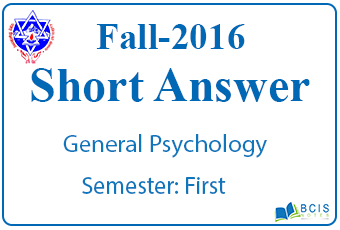
Very Short Questions Fall 2016
The answers to the Very Short Questions Fall 2016 are given below:
1. Define Psychology. Distinguish between S-R and S-O-R.
ANS- Psychology is the science of mind and behaviour. Psychology includes the study of conscious and unconscious phenomena, as well as feeling and thought.
Stimulus-response (S-R) theories are central to the principles of conditioning. They are based on the assumption that human behaviour is learned.
S-O-R psychology is the abbreviation for stimulus – organism – response psychology. It deals with how an organism will respond to a stimulus. The O factors in this abbreviation could be biological or psychological.
2. Why pituitary gland is called the master gland?
ANS- The pituitary gland is sometimes called the “master” gland of the endocrine system because it controls the functions of many of the other endocrine glands. The pituitary gland is no larger than a pea and is located at the base of the brain.
3. What is Perceptual organization?
ANS- Perceptual organization is the process of giving structure to our experience of objects, scenes, and events in the world. The literature on this complex and fascinating topic is huge, dealing with a wide range of phenomena, processes, neural mechanisms, models, and theories.
4. Differentiate prejudice and discrimination with suitable examples.
ANS- Prejudice means “pre-judged.” A person who has prejudiced opinions relies on stereotypes. When meeting someone with a different background from themselves, they may believe they already know everything about that person.
Discrimination occurs when a person allows their prejudice to influence their behavior. Discrimination against protected classes is illegal in most cases, as it can violate a person’s civil rights.
5. Define reinforcement and punishment.
ANS-
| BASIS FOR COMPARISON | REINFORCEMENT | PUNISHMENT |
|---|---|---|
| Meaning | Reinforcement, implies the process of supporting or promoting a pattern of behavior. | Punishment entails the act of penalizing or forfeiting something of value, to repress an undesirable behavior. |
| What is it? | An enthusiastic outcome. | An aversive outcome. |
6. Discuss briefly the methods used in problem-solving.
ANS- The methods used in problem-solving are given below:
- Heuristic
- Algorithm
- Trial and error
7. Point out the confluence approach to creativity.
ANS- Confluence theories of creativity offer the possibility of accounting for diverse aspects of creativity (Lubart, 1994). For example, analyses of scientific and artistic achievements suggest that the median-rated creativity of work in a domain tends to fall toward the lower end of the distribution and the upper – high creativity – tail extends quite far.
8. What is homeostasis?
ANS- Homeostasis is the ability to maintain internal stability in an organism in response to the environmental changes. The internal temperature of the human body is the best example of homeostasis.
9. What are the physiological needs and why they are placed at a basic level?
ANS- Definition of Physiological Needs These are biological needs required to preserve human life. These needs mainly consist of oxygen, food, water, clothing, and shelter. They are placed at a basic level because without these need being fulfilled we cannot achieve other needs.
10. Mention major types of personality measurement techniques.
ANS- Measurement of personality serves both theoretical and practical purposes. The different methods are non – projective and projective.
You may also like Pokhara University || Fall,2016 || General Psychology

Leave a Reply